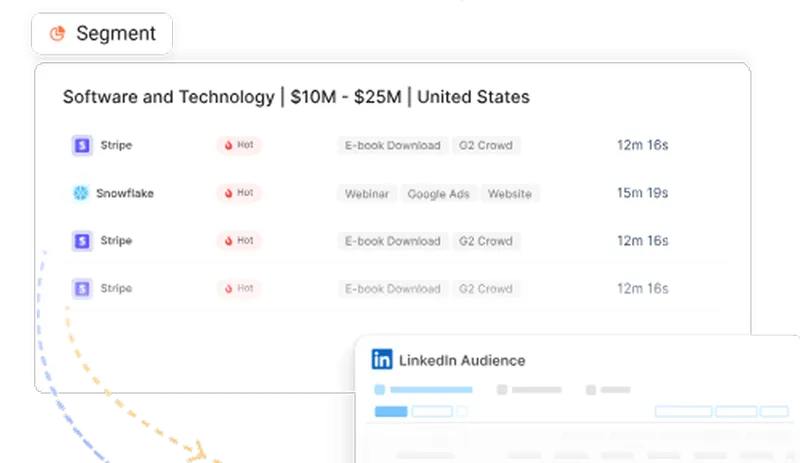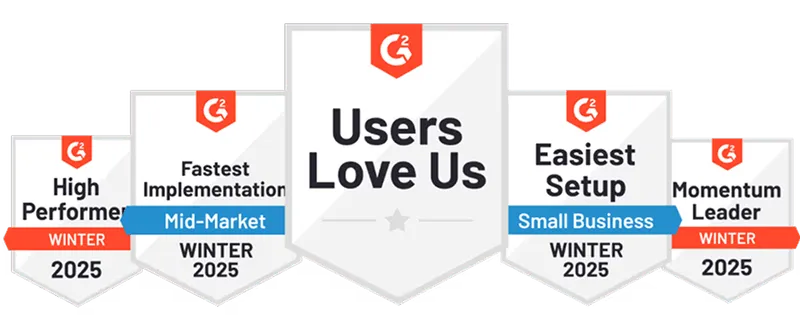MQL vs SQL: The Key Difference Driving Sales & Marketing Alignment
Learn the difference between MQL and SQL, when to transition leads, and how to align sales & marketing to boost conversions.
Every successful revenue engine depends on one thing: the ability to separate interested prospects from real buyers. No matter how much traffic your website attracts or how many campaigns you run, growth only happens when you can identify which leads deserve immediate sales attention and which ones need nurturing. The primary difference between a Marketing Qualified Lead (MQL) and a Sales Qualified Lead (SQL) is the lead's purchase intent and the specific marketing or sales approach required for each.
Think of it like dating; not everyone who shows interest is ready for a relationship. Some are only demonstrating initial interest and just want to know more, while others are ready to commit. Your job is to figure out who’s who. That’s where lead qualification (this blog) comes in.
Also, read lead generation 101.
TL;DR
- MQLs are leads showing early engagement and curiosity, not ready to buy but open to nurturing.
- SQLs show strong intent with actions like demo requests, pricing inquiries, or product comparisons, ready for direct sales outreach.
- Clear qualification turns a messy funnel into a predictable revenue engine.
- Sales and marketing alignment ensures smooth handoffs and faster conversions.
- Shared lead scoring models and automated workflows keep teams focused on the right leads.
- Tools like Factors track signals, trigger actions, and surface opportunities in real time.
- Avoid common pitfalls like pushing leads too early, waiting too long, or misjudging intent.
- AI-driven predictive lead scoring, real-time intent data, and deeper attribution are shaping the future of lead qualification.
- Nailing the MQL-to-SQL transition means more pipeline, higher win rates, and scalable growth.
What is sales funnel and lead management
Think of the sales funnel as a filtering system. At the top, you have a broad mix of visitors, blog readers, ad clickers, webinar attendees, and curious trial users. But like I said above, not everyone at the top is ready to buy. Some are just exploring, some are gathering information, and only a fraction have genuine purchase intent.
Lead management is the process of sorting through this noise, qualifying leads based on data and signals, and ensuring that the right contacts move from one funnel stage to the next. When done correctly, this process eliminates wasted sales effort, aligns marketing with revenue goals, and drives higher win rates.
Importance of effective lead qualification in business growth
A poorly qualified funnel is like running ads with no targeting: expensive and inefficient. You might get lots of clicks, but if none of them turn into customers, what’s the point? It’s like throwing darts in the dark; you’re bound to miss most of the time. And those misses hurt your metrics, drain time, energy, and resources across the team.
Often, sales reps waste hours chasing leads who were never going to buy, while high-intent prospects slip through the cracks. Flip that equation with proper lead qualification, and the difference is dramatic:
- Higher conversion rates - because sales only talks to leads that match your ICP and show intent.
- Shorter sales cycles - because SQLs (Sales Qualified Leads) are contacted at the right buying moment.
- Better marketing ROI - because budgets are focused on campaigns that generate quality leads, not vanity metrics.
The difference between a scalable revenue engine and a stalled pipeline often comes down to how clearly a company defines and manages MQLs and SQLs.
What are MQLs and SQLs
Marketers and sales teams often throw these acronyms around, but definitions vary widely across companies. Because if you’ve ever been in a marketing meeting, you’ve probably heard these terms tossed around like confetti.
Let’s see:
- MQL (Marketing Qualified Lead): A lead that has engaged with your marketing (downloaded an eBook, signed up for a newsletter, attended a webinar) and fits your ICP. They’ve shown interest but aren't ready to buy yet.
- SQL (Sales Qualified Lead): A lead that has crossed the intent threshold. They’ve either requested a demo, asked for pricing, or engaged in behavior that indicates they’re evaluating solutions seriously. Sales can confidently prioritize them.

This is where the MQL vs SQL distinction matters most. MQLs are nurtured until they’re ready, while SQLs are handed off immediately to sales for follow-up. Confusing the two wastes resources and leads to frustration on both sides.
How MQLs and SQLs fit into the overall sales and marketing strategy
Think of MQLs and SQLs as two gears in the same machine. Marketing creates awareness and nurtures prospects into MQLs. Once the lead shows clear buying intent, it becomes an SQL and enters the sales pipeline.
When marketing and sales align on what qualifies as an MQL vs SQL, the handoff becomes seamless. Marketers can measure success in terms of how many MQLs convert into SQLs, while sales can focus their energy on leads that are truly ready to buy. This shared framework strengthens collaboration, reduces missed opportunities, and ultimately drives more predictable revenue growth.
What is the main difference between MQL and SQL
In sales and marketing, the line between interest and intent is razor-thin. Misjudge it, and you either push leads too soon (risking churn) or wait too long (missing the buying window). That’s why the distinction between MQL and SQL is critical. Let’s break down the key differences.
Also read https://www.factors.ai/blog/post-sale-customer-journey-framework
What is an MQL? And what are its characteristics?
A Marketing Qualified Lead (MQL) is a prospect who has interacted with your brand in meaningful ways but is not yet ready for a direct sales pitch.
- Definition: A lead that meets baseline ICP criteria and has shown early buying interest through marketing channels.
- Signals: Downloaded an eBook, attended a webinar, engaged with multiple emails, or browsed your product pages.
- Stage: Middle of the funnel, aware of their problem, exploring potential solutions.
- Action required: Nurturing through content, ads, and automated workflows.
In short, an MQL is a potential buyer who says, “I’m interested, but not just yet.”
What is an SQL? And what are its characteristics?
A Sales Qualified Lead (SQL), on the other hand, is ready for direct engagement.
- Definition: A lead that has demonstrated clear buying intent and meets sales-readiness criteria.
- Signals: Requested a demo, visited the pricing page multiple times, asked for a product comparison, or directly contacted your team.
- Stage: Bottom of the funnel, actively evaluating vendors or making purchase decisions.
- Action required: Timely outreach from SDRs or AEs, qualification calls, and opportunity creation.
An SQL essentially says, “I’m evaluating solutions. Convince me why yours is the right fit.”
Criteria used to identify MQLs vs SQLs
The SQL meaning marketing teams use often varies, but successful organizations define clear, measurable criteria. In other words, guessing isn’t an option here; the clearer your criteria, the less time your team wastes chasing the wrong people.
Here’s what typical MQL criteria often include:
- MQL criteria:
- Fits ICP (industry, size, persona)
- 3+ high-intent web visits in 30 days
- Consumed gated content (eBook, case study, whitepaper)
- Opened multiple nurture emails
- SQL criteria:
- Completed demo or trial sign-up
- Multiple visits to pricing or product comparison pages
- Responded positively to sales outreach
- Scoring threshold surpassed (e.g., >80 points)
(For more on scoring models, read Unlocking the Secrets of Lead Scoring Models)
The Role MQLs and SQLs play in the customer journey
- MQLs: Fuel the middle of the funnel. They show interest, need education, and are not yet ready to be approached by sales.
- SQLs: Fuel the bottom of the funnel. They are closer to a purchase decision, ready for sales engagement, and need tailored conversations.
Without MQLs, the funnel dries up. Without SQLs, the funnel never converts. Together, MQL and SQL form the backbone of a healthy pipeline.
Also read https://www.factors.ai/blog/stages-of-the-customer-journey
Common indicators and signals for qualification
- Behavioral: Content downloads, repeat visits, webinar registrations → MQL. Demo requests, trial usage, pricing page visits → SQL.
- Firmographic: Company size, industry, revenue → filters for both MQL and SQL qualification.
- Technographic: Tools currently in use → helps decide sales relevance.
- Intent signals: Ads engagement, G2 research, product activity.
At a glance: Here’s how MQLs and SQLs differ
Here’s why the distinction matters
When teams blur SQL vs MQL definitions, the entire revenue process breaks. It’s a bit like passing the baton in a relay race. If one team doesn’t know when to hand it over, the whole thing slows down (or worse, collapses).
And that’s exactly what happens in many organizations: marketing floods sales with unready leads (hurting SDR efficiency), or sales misses high-intent leads because they weren’t flagged in time. Clear separation ensures:
- Marketing measures success by MQL→SQL conversion.
- Sales measures success by SQL→Opportunity conversion.
- Leadership sees predictable pipeline progression across the funnel.
To understand how sales and marketing can collaborate better at this stage, explore our 6 Tips to Align Sales and Marketing Teams.
Challenges and pitfalls: Common traps when defining MQLs vs SQLs
Even experienced teams encounter difficulties when drawing the MQL/SQL line. Common pitfalls include:
- Overqualification: Labeling too many leads as SQLs before they’re ready. This leads to wasted outreach and sales fatigue.
- Underqualification: Holding onto MQLs for too long, which delays engagement and causes competitors to swoop in first.
- Siloed systems: Marketing automation platforms and CRMs that don’t sync create inconsistent lead statuses, confusing SDRs.
- Lack of feedback loops: Without sales feedback, marketing doesn’t know which MQL behaviors actually predict SQL conversion.

Avoiding these pitfalls requires both technology (CRM + automation) and process discipline (weekly feedback loops, clear scoring rules, documented SLAs).
Why the MQL–SQL Distinction Matters for Growth
At the end of the day, the MQL vs SQL distinction is about more than labels. It’s about ensuring your revenue engine runs efficiently:
- Marketing focuses on quality, not just volume.
- Sales focuses on timing, not just effort.
- Leadership gains predictability across the funnel.
Get it right, and your funnel becomes a growth multiplier. Get it wrong, and it becomes a costly bottleneck.
Here’s how defining MQLs and SQLs impacts business growth
The distinction between MQLs and SQLs isn’t just a matter of terminology; it has direct, measurable consequences on how efficiently a business grows. Companies that clearly define and operationalize MQL vs SQL are able to build predictable revenue systems. Companies that blur the line struggle with wasted effort, lost deals, and misaligned teams.
- Impact of lead qualification on sales pipeline efficiency and conversion rates
One of the strongest outcomes of proper qualification is improved pipeline efficiency.
- Higher-quality SQLs mean higher conversion rates. If sales is handed leads who are already showing intent signals, win rates increase naturally.
- Shorter cycle times. When SQL sales teams receive qualified prospects at the right moment, they can engage quickly before interest decays.
- Cleaner pipeline visibility. Leadership can forecast accurately because MQL→SQL→Opportunity conversion ratios are reliable.

A mismanaged funnel has the opposite effect: bloated pipelines filled with weak opportunities, wasted SDR time, and frustrated marketers.
Common pitfalls to watch out for
- Pushing leads to sales before they show real buying intent.
- Setting criteria so strict that promising leads never make it through.
- Working in silos without feedback or shared context.
- Ignoring sales feedback when refining qualification models.
- Relying on a static scoring model instead of adapting over time.
Here’s how proper qualification improves marketing ROI
Marketing budgets are finite. If a team optimizes campaigns purely for lead volume without considering quality, ROI plummets.
By distinguishing SQL vs MQL, marketing can:
- Identify which campaigns generate leads that actually convert into SQLs.
- Shift spend toward high-quality channels (for example, G2 or high-intent search) instead of vanity metrics (e.g., low-cost leads from broad awareness ads).
- Prove contribution to pipeline in terms of SQL creation, not just MQL volume.
This closes the loop on SQL marketing impact: marketing doesn’t just generate interest. Having clear thresholds avoids the guesswork it directly fuels revenue by creating SQLs.
And when it comes to measuring which channels actually contribute to that growth, accurate attribution becomes essential. The Factors B2B Marketing Attribution Guide highlights the biggest challenges companies face and how multi-touch attribution connects every click to revenue.
Aligning marketing and sales for a seamless handoff
A classic failure point in many organizations is the ‘throw it over the wall’ mentality: marketing generates leads, hands them to sales, and hopes for the best.
Even the most sophisticated lead qualification process can fall apart if marketing and sales aren’t on the same page. It’s not enough to define MQLs and SQLs, both teams need to collaborate continuously to ensure every handoff is timely, relevant, and acted on.
How to strengthen marketing and sales collaboration
- Evolve shared definitions: Go beyond just agreeing on MQL and SQL criteria once revisit and refine them regularly as buyer behavior and ICP insights evolve.
- Turn communication into a system: Don’t limit alignment to monthly syncs. Set up recurring lead review sessions where both teams analyze what’s working, what’s not, and how scoring can improve.
- Recycle rejected leads effectively: Not every SQL will convert immediately. Instead of dropping them, feed them back into marketing workflows for continued nurturing.
- Build joint dashboards and KPIs: Move past vanity metrics. Create shared views of conversion rates, velocity, and pipeline impact so both teams measure success on the same terms.
Strategic recommendations for aligning marketing and sales efforts
- Define thresholds clearly. Document exactly what makes a lead an MQL vs SQL.
- Automate handoffs. Use CRM workflows and real-time alerts so no SQL falls through the cracks.
- Enforce SLAs. Sales must act on SQLs quickly; marketing must deliver only leads that meet criteria.
- Measure success across stages. Track MQL→SQL conversion rates, SQL→Opportunity rates, and ROI from each campaign.
- Create a feedback loop. Sales shares qualitative input on SQL quality; marketing refines scoring models based on that data.
Look, marketing and sales alignment isn’t a one-time fix; it’s a discipline. But with the right frameworks and the right platform, it becomes easier, faster, and far more scalable.
Best practices for managing MQLs and SQLs effectively
Knowing the difference between MQL vs SQL is only half the battle.
The real growth comes from how you manage these leads, how you define them, nurture them, transition them, and continuously refine the process.
Let’s break down the best practices that top-performing teams use to maximize lead conversion.
- Develop clear qualification criteria and scoring models
The foundation of effective lead qualification is a transparent, points-based scoring model.
- Fit (Firmographic/ICP criteria): Industry, company size, geography, tech stack.
- Intent (Behavioral criteria): Page visits, webinar attendance, content downloads, product trial activity.
- Recency: How recently those actions occurred (a demo request last week is stronger than one six months ago).
For example:
- A prospect from your ICP who attended a webinar (+20), downloaded an eBook (+10), and visited the pricing page twice (+30) might hit the 60-point threshold for MQL.
- Once they request a demo (+30) or actively engage with a rep (+20), they cross the 80-point threshold into SQL.
Having clear thresholds avoids the guesswork. Sales knows why a lead was passed over, and marketing knows what behaviors to prioritize.
Factors helps you visualize this transition through its Milestones feature, which offers funnel analytics that pinpoint what actions drive movement from MQL → SQL, so you can double down on what works.
- Implement lead-nurturing strategies for MQLs
MQLs and SQLs require different engagement strategies. An MQL should never be treated like an SQL; doing so risks scaring them away before they’re ready.
For MQLs:
- Content drip campaigns: Educational content → case studies → product comparisons.
- Retargeting ads: Serve content to high-fit accounts browsing your site but not converting.
- Personalized nurture: Use marketing automation to send emails aligned with their activity (e.g., “Since you downloaded our product guide, here’s a webinar you might like”).
The goal is to warm them until intent signals show they’re ready to progress.
- Transition leads from MQL to SQL: timing and communication
The handoff moment is where most companies lose momentum. Without speed and clarity, hot leads go cold.
Best practices include:
- Service Level Agreements (SLAs): Documented rules, e.g., Sales must engage an SQL within 24 hours.
- Automated alerts: Slack/MS Teams messages triggered when a lead reaches SQL status.
- CRM workflows: Automatically assign SQLs to the correct SDR, create tasks, and log activity.
Example: If a prospect hits the SQL threshold at 10 a.m. after browsing the pricing page, an SDR alert should fire instantly. Waiting until the weekly sync to act wastes the signal.
- Use CRM and marketing automation tools for seamless handoffs
Technology ensures consistency. Modern GTM stacks make SQL sales handoffs smooth and measurable.
- CRM systems (Salesforce, HubSpot): Track lead status changes from MQL → SQL → Opportunity.
- Marketing automation (Marketo, Pardot, HubSpot): Score and nurture MQLs until they’re ready.
- ABM/ad platforms: Sync high-intent MQL segments into LinkedIn or Google Ads for precision retargeting.
This integration ensures marketing and sales are never blind to each other’s activities. For example, SQL marketing teams can see which campaigns sourced SQLs, while sales can give feedback on which MQL signals actually led to opportunities.
- Continuously monitor and refine qualification processes
Lead qualification is not a “set it and forget it” system. Buyer behavior changes, markets shift, and what worked last quarter may not hold next year.
Best practices include:
- Weekly or bi-weekly MQL→SQL reviews: Marketing and sales analyze which signals worked and which didn’t.
- Adjust scoring weights: If trial usage proves more predictive than eBook downloads, increase its point value.
- Feedback loops: Sales shares qualitative feedback on why certain SQLs closed or stalled, informing marketing.
- KPI tracking: MQL→SQL conversion rate, SQL→Opportunity rate, average time-to-SQL, win rate by source.
Also read: KPIs Explained: Conversion Rates
Continuous refinement turns the MQL and SQL framework into a living system that evolves with your business.
Putting it together: Steps for predictable growth
Here’s what a streamlined MQL-to-SQL qualification process looks like from start to finish:
- Define MQL and SQL thresholds (with scoring tied to ICP + intent).
- Nurture MQLs with targeted content, ads, and automation.
- Trigger handoff automatically when SQL criteria are met.
- Enforce SLAs so sales acts quickly on SQLs.
- Review and refine scoring and signals every week.
The result? Sales spends time on the right accounts, marketing proves ROI beyond vanity metrics, and leadership gets a clean, predictable pipeline.
How Factors helps
Most teams struggle with the MQL→SQL handoff because marketing and sales speak different languages. Marketing tracks engagement; sales tracks intent. Somewhere in between, leads get lost. That’s where Factors brings everyone back on the same page.
Factors simplifies alignment by giving both teams a shared source of truth. Features like Milestones visually map the journey from MQL to SQL, showing exactly which actions or content drive progression between stages. With these funnel analytics, you can finally diagnose drop-offs, validate GTM experiments, and double down on what’s working.
Meanwhile, real-time AI Alerts notify sales reps the moment a lead crosses an intent threshold, like revisiting the pricing page or engaging with multiple assets. These alerts don’t just say who to reach out to, but why and how, surfacing rich account context for hyper-personalized follow-ups. It means your reps never miss a ready buyer, and marketing gets immediate feedback on what’s driving sales conversations.
To take it a step further, GTM Engineering combines AI Agents and execution services that turn intent into revenue. Agents automatically:
- Alert reps in real time when an account is ready to talk
- Pull detailed account research
- Identify and multi-thread buying groups
- Revive closed-lost deals
- Track post-meeting engagement to guide next steps
This automation ensures every follow-up is timely, relevant, and backed by context.
Now, all this intelligence feeds into Factors’ Account 360, a unified view of every touchpoint, from ads and content engagement to sales outreach. It gives your GTM teams complete visibility into the buyer journey, so marketing knows which campaigns are driving SQLs, and sales knows exactly what the account has seen, done, and responded to.
And with Dynamic Ad Activation, you can sync audiences to LinkedIn and Google Ads in real time, ensuring every campaign stays in sync with funnel progression. Run buyer-stage–specific campaigns, retarget high-intent accounts, and suppress low-quality leads, automatically.
Together, these features transform lead qualification from a guessing game into a repeatable, data-backed process. Forget disjointed dashboards or manual CSV uploads, and those alignment meetings that go in circles. (I can hear you breathe a sigh of relief!)
With Factors, alignment stops being a recurring pain point and becomes a revenue-driving habit, powered by shared visibility, smart automation, and AI that connects intent to action.
Future trends in lead qualification and sales enablement
Lead qualification is evolving quickly. The truth is, the way we qualify leads today might look completely different in just a couple of years and that’s not a bad thing. Here’s a glimpse of what that future is starting to look like:
- AI-driven scoring: Machine learning models now combine behavioral, firmographic, and product usage fdata to predict intent with far greater accuracy.
- Real-time intent data: Integration of external signals like review site activity, funding data, or hiring patterns into lead scoring.
- Deeper ad platform integrations: Expect SQL marketing workflows that sync high-intent accounts into ad campaigns in near real time.
- AI assistants in sales: SDRs increasingly rely on AI agents that not only identify high-intent accounts but also surface the right contacts and generate personalized outreach insights.
In a nutshell…
The MQL vs SQL debate determines how effectively your revenue engine runs. MQLs represent early interest and the potential for future opportunities. SQLs, on the other hand, represent immediate buying intent and the chance to close deals quickly.
MQLs and SQLs are not interchangeable. Confusing them leads to wasted resources, missed opportunities, and frustrated teams. Clear definitions and scoring rules ensure that marketing fuels pipeline with quality leads and sales engages only when prospects are ready. The SQL meaning marketing teams rely on must tie directly to measurable business outcomes like conversion rates, pipeline growth, and ROI.
Both are essential, but they require different playbooks, timelines, and ownership.
FAQs for MQL vs SQL
Q1: What is the main difference between MQL and SQL?
A: An MQL is a lead who has shown interest through marketing activity but isn’t ready for sales yet. An SQL has demonstrated clear buying intent and is ready for direct sales engagement.
Q2: Why is it important to distinguish between MQLs and SQLs?
A: Mixing the two wastes time and resources. The distinction ensures that marketing focuses on nurturing and sales focuses on closing, improving overall pipeline efficiency.
Q3: What does SQL mean in marketing?
A: In marketing, an SQL is a lead that has passed qualification criteria, showing intent signals like demo requests or pricing inquiries, and is ready for sales outreach.
Q4: How do you convert MQLs into SQLs?
A: Through lead nurturing, emails, ads, content, and retargeting, until the lead crosses defined scoring thresholds (e.g., demo requests, pricing page visits).
Q5: What KPIs should businesses track for MQLs and SQLs?
A: MQL→SQL conversion rate, SQL→Opportunity conversion rate, average time-to-SQL, pipeline sourced by SQLs, and win rate by origin channel.
Q6: Can a lead skip MQL and go directly to SQL?
A: Yes. If a prospect shows strong buying intent from the start like requesting a demo or contacting sales they can skip the MQL stage and become an SQL immediately.
Q7: How many MQLs convert to SQLs?
A: There isn’t a universal benchmark as it varies by product, ICP, lead source, and how you define each stage. The most useful benchmark is your own: track MQL→SQL by channel/segment over a consistent window (e.g., last 90 days) and improve it by tuning fit criteria, scoring, SLAs, and nurture..
Q8: What SQL means in marketing?
A: It refers to a lead that’s shown clear buying intent and is ready for direct sales engagement, usually after taking actions like requesting pricing or booking a demo.
Q9: What’s the difference between “SQL sales” and “SQL marketing”?
A: “SQL marketing” is how marketing identifies a lead as sales-ready. “SQL sales” is how the sales team qualifies and engages that lead to move it into an opportunity.
Q10: Do all SQLs become customers?
A: No. Some SQLs don’t convert due to factors like timing, budget, or competition, but strong qualification increases the chances they will.
Related Reads from Factors
If you’re looking to improve how your team defines, qualifies, and moves leads from MQL to SQL, these reads can help you sharpen the foundation:
- How To Build Your Ideal Customer Profile In 15 Steps – A practical guide to defining your ICP so your MQLs and SQLs are more targeted, qualified, and conversion-ready.
- How To Leverage Signals For Account Scoring – Learn how to use intent and engagement signals to fine-tune lead scoring models that bridge the MQL→SQL gap.
- An Introduction To B2B Account Scoring - Understand the basics of account-level scoring to ensure sales teams focus on the highest-potential opportunities first.
See how Factors can 2x your ROI
Boost your LinkedIn ROI in no time using data-driven insights


See Factors in action.
Schedule a personalized demo or sign up to get started for free
LinkedIn Marketing Partner
GDPR & SOC2 Type II
.svg)










